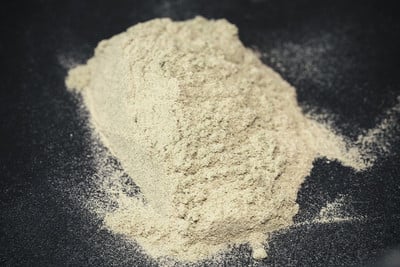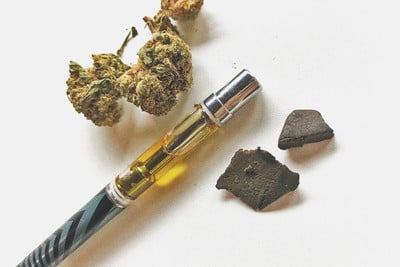.

How to Avoid Poor-Quality Hash
Many cannabis users view hash with great respect. This ancient form of cannabis concentrate delivers high quantities of tasty terpenes and stoning THC. However, not all hash is created equal. In fact, some hash contains nasty fillers and can even harm your health. Learn exactly how to set apart the quality hash from the inferior or dangerous.
If you’re an experienced stoner, you’ll know that cannabis can vary drastically in quality from sample to sample. As a concentrate made from the resin glands on weed flowers, the same is true for hash. A long list of factors can impact the quality of this product, including the plant material used, its terroir[1], and the processing strategies employed post-harvest.
Regardless of the type of hash you prefer to consume, it’s important to learn how to identify the indicators of quality. Not only will this ensure a more pleasant experience, but it’ll help you to avoid exceptionally poor-quality products that pose a genuine health concern. Learn the ropes below!
Contents:
What Types of Hash Are Out There?
Before we dive into the nuances of good hash vs bad hash, let’s explore the diverse range of hash products that are typically available in dispensaries, coffeeshops, or from your local entrepreneurial artisan. The major categories of hash include:
- Charas: Made for thousands of years on the Indian subcontinent, charas is created by collecting the resin from live cannabis flowers between the palms, and then rolling it into spheres. Because growers harvest the resin before drying the buds, these spheres are packed with flavour and offer a unique viscosity and freshness.
- Bubble hash: Also known as ice water hash, bubble hash is a popular modern method of procuring concentrated trichomes. Manufacturers use an ice water wash to dislodge resin glands from plant material, then filter and dry this cool slurry to produce a pure and flavourful end product.
- Dry sift hash: As the name suggests, this method of hash-making involves agitating dried flowers over a fine mesh screen, causing dislodged trichomes to fall through into a collection tray. The harvested trichomes are then pressed together to form a cohesive brick of disc of hash. Some weed users refer to unpressed dry sift hash as kief.
- Soap bar hash: This form of hash, originating in Morocco, gained a terrible reputation in Europe in the 1990s, and rightly so. Known as soap bar hash because of the shape of the 250g bars traffickers transported it in, this product frequently contained fillers used to increase the product's weight and ultimately make the producers more money. These fillers are rumoured to have included beeswax, pine resin, and even glues. Soap bar hash is, thankfully, very rare to come across nowadays.
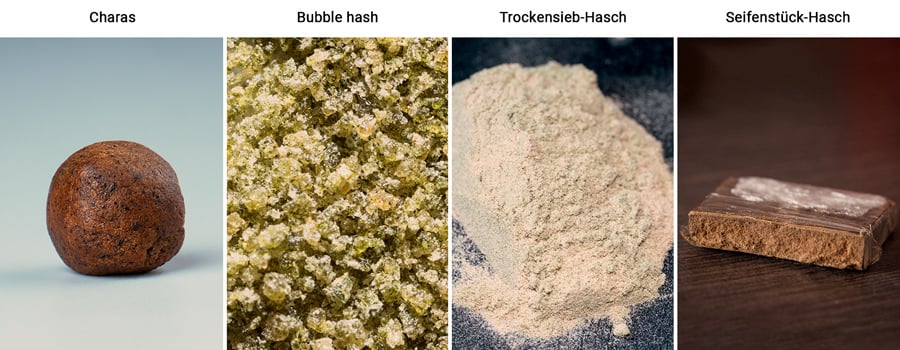
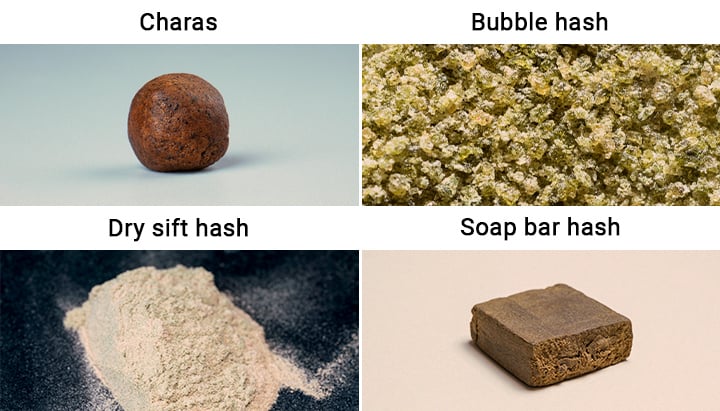
What Does Quality Hash Look Like?
Now you’re aware of some of the most common types of hash, from the elite to the unworthy. However, the quality of hash within all of these categories can vary widely. There are many different variables at play when it comes to the calibre of hash, and many of these are unquantifiable to the consumer. However, you can improve the odds of spending your money on a good product by looking for the specific signs outlined below.
Colour
Even among samples that belong to the same tier of quality, the colour of hash can vary significantly. You’ll find excellent examples of hash that range from pale blonde to deep amber—an indication of the maturity of the trichomes. You’ll also come across both light and dark shades of brown. All of these are acceptable colours. Some forms of hash are, in contrast, almost black. If uniform and homogeneous, the quality is likely good. If lumpy and too crumbly, however, it could contain a bunch of plant material and chlorophyll.
Texture and Consistency
Good-quality hash should never appear runny with a high water content, nor should it feel excessively firm and require you to forcefully break it apart. Instead, it should feel pliable and malleable; sticky but easy to manipulate. You should be able to roll it up into a ball or sausage, while also being able to crumble it up into joints or blunts.
Trichome Density
Some novice hash users wonder whether they should try to assess trichome density when analysing hash quality. Well, good luck with that! As a homogenous mass of mostly ruptured trichomes, you have no chance of guessing the trichome load of a sample of hash. If you’re dealing with pure stuff, then the mass alone will determine how many trichomes and how much resin you’re dealing with. Impure hash will contain fewer trichomes, but without technical analytical equipment, you won’t know the exact ratio.
Purity
Different types of high-quality hash come with distinct flavours, textures, and colours, which can make determining quality a bit difficult. However, purity certainly sets the premium hash apart from the garbage. As seen during the soap bar era, bad actors in the weed supply chain are known to use fillers when making hash to flip a bigger profit. If you buy hash from a reputable dispensary, ask nicely, and they might let you take a look at batch testing results that contain heavy metal, pesticide, and mycotoxin figures. Unfortunately, you won’t have this kind of luxury with local dealers and other less official sources of cannabis-based products.
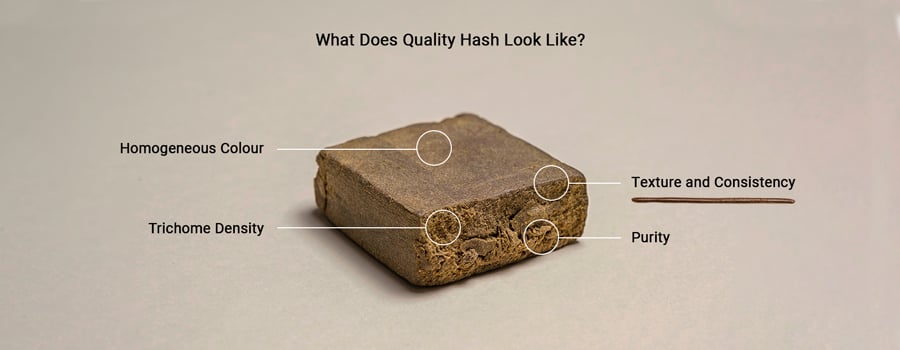
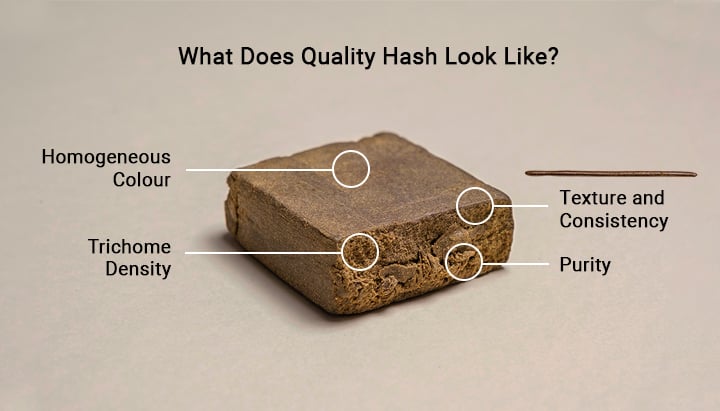
Does Hash Smell? Evaluating Aroma and Flavour
You bet it does! Think about this for a second. Cannabis smells so strongly because of the secondary metabolites it produces—namely, terpenes and volatile sulphur compounds, among others—which are present chiefly in the trichomes. This means that quality hash, as a mass of ruptured trichomes, is packed full of aromatic molecules and therefore smells and tastes strong. Poor-quality hash, on the other hand, may smell grassy and be devoid of any complex flavour.
Flavour and Taste
So, what does good hash smell and taste like? You’ll encounter a wide range of tastes and aromas in good-quality hash. Depending on the secondary metabolite profile of the flowers, you’ll encounter notes of pine, wood, fruit, citrus, berries, skunk, pepper, earthiness, and much more. Regardless of the specifics, fine hash will serve up a pleasant and complex aroma and flavour. In contrast, poor-quality hash will taste harsh, bitter, and sometimes even chemical.
Hash Burning
After going through all of the other checks, you’re likely ready to get to the meat of the matter and smoke up your hash. However, we suggest crumbling off a segment and applying a flame to it for one final step of the vetting process. Place your hash on the end of a butter knife and apply a flame. The sample should turn dark grey and release a pleasant odour. You’ll also notice a slight bubbling as the oils in the hash volatilise. In contrast, bad hash will smoulder, burn black, and sometimes emit a chemical smell.

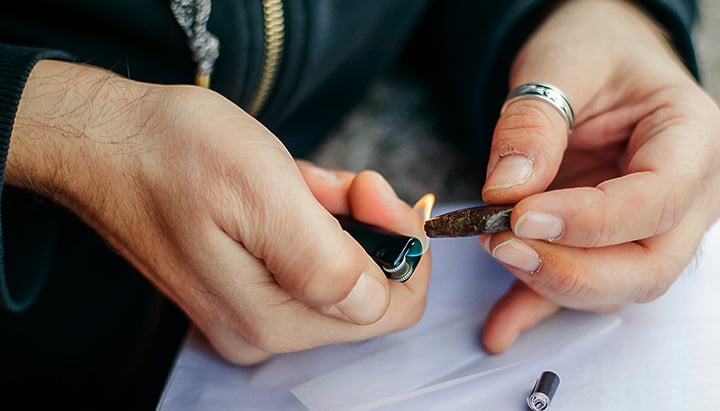
The Bubble Test
If you’re dealing specifically with bubble hash, you can conduct the so-called bubble test to help determine its quality. As you can probably guess, bubble hash got its name because it bubbles when heated. To get a rough idea of the purity and resin content of your bubble hash, carry out the following steps:
- Take a small sample of your bubble hash.
- Place your sample within a heat-proof container, such as a pipe or bong bowl.
- Apply a flame to the outside of the container to heat up your sample via conduction.
- Check out how your hash reacts to the heat. It should bubble vigorously, indicating the resin content of your stash.
Your First Steps Toward Hash Connoisseurship
Do you feel that? That’s the feeling of your brain lighting up with new knowledge! You’ve taken a step further toward true hash connoisseurship. Granted, you’re no Frenchy Cannoli just yet, but you’re aware of how to set apart the good hash from the bad. Not only will this help you get your hands on some of the best hash within your locality, but it’ll keep you from inhaling poor-quality products contaminated with potentially dangerous fillers. You’ll enjoy that next bowl of hash more than any other you’ve had previously!
- Moroccan hashish as an example of a cannabis terroir product | SpringerLink https://link.springer.com


























